Charging patients can help offset your incurred expenses for PPE items. Make sure you’ve set things up in Dentrix before you begin.
Some offices are charging a fee for the additional personal protective equipment that is required to prevent the spread of COVID-19 and other diseases. The American Dental Association has suggested the use of the procedure code D1999 to charge for this additional PPE*.
If your practice decides to use this code, here are some things you can do in Dentrix to make using it a little easier.
1- Edit the Procedure Code
First you will need to edit the procedure code and attach a fee for the code in the Procedure Code Editor in the Office Manager. Select code D1999 from the Preventive category and click Edit. You can then change the description and abbreviated description for the code to “PPE.” You can also edit the fee in this dialog box as well. The fee you will charge for PPE should be determined by your practice owner based on the cost of additional PPE items, such as gowns, face shields, shoe coverings, an oral rinse, and so forth. Although it varies by state and area, I’ve seen the D1999 charge for PPE range from $10-$25.
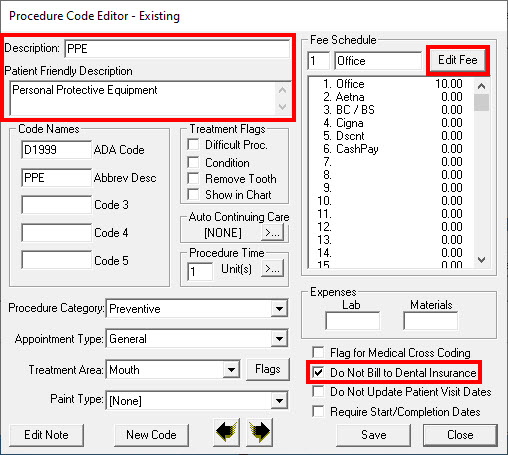
If you aren’t planning to bill the code to dental insurance, or if you don’t expect insurance to pay and you want to have patients pay this expense, you can select Do Not Bill to Dental Insurance within the procedure code setup, and Dentrix will include the fee in the patient portion of charges.
2- Add the Code to Initial Reasons for Appointments
Adding the code to the Initial Reasons box makes it quick and easy to add it to an appointment. The Initial Reasons box is available within the Appointment Information dialog box and typically includes commonly scheduled procedures like a prophy or bitewing X-rays. You can edit the procedures that appear as options to choose from in the Initial Reasons box in the Office Manager. Click Maintenance > Practice Setup > Definitions.
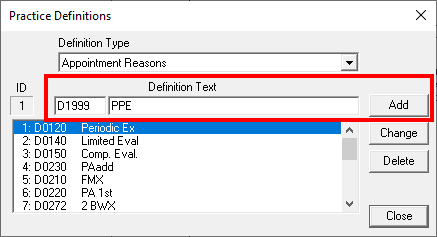
In the Definition Type drop-down list, select Appointment Reasons. Add procedure code D1999 and in the Definition Text field, give the code a name that will make sense to the team. This could be as simple as “PPE.” Click Add, and the code will then be easily accessible to add to each appointment along with the procedures the patient is coming in for. Then be sure to train your staff to add the D1999 code to every appointment.
3- Create a Custom Claim Remark (Narrative) to Add to Claims
If you plan to bill D1999 to insurance for patients, you can create a custom narrative template you can access from the Remarks for Unusual Services block on the insurance claim. Click Claim Remarks and select the PPE template to add the narrative to each claim.
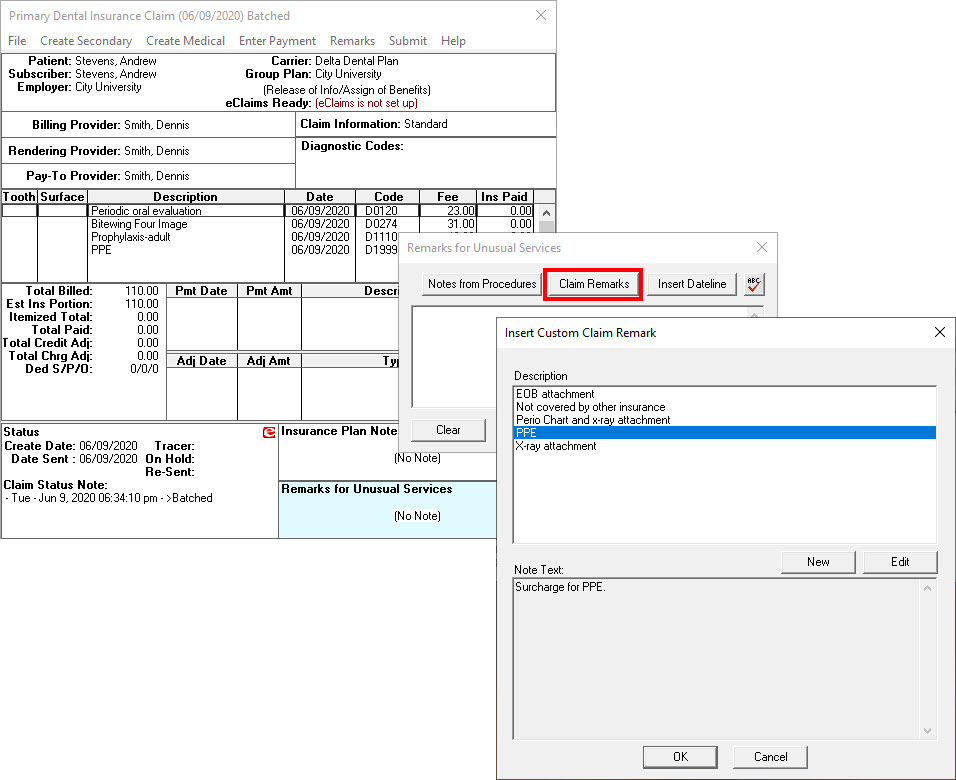
4- Create Custom Clinical Notes
If you use clinical note templates in the Patient Chart, you can create a new template where you describe the additional use of PPE due to COVID-19. This will support your office charging a fee for additional PPE. Make sure that staff is trained to add this new clinical note for patients that have the fee charged on their appointment.
5- Update Payment Tables with Insurance Coverage for PPE
Recently, some dental insurance companies have announced that they will compensate providers for the cost of PPE. Whether an insurance plan will pay this charge or not, I do think it’s a good idea for practices to charge patients this additional fee. Although some PPE is the norm in dental offices, the additional requirements of gowns, face shields, and N95 masks are an additional cost that practices should be compensated for.
The average of what offices are charging for PPE is around $10. If you expect dental insurance to pay a portion of the charge for PPE using code D1999, I would highly suggest using the payment table in Dentrix in order to collect accurately from patients.
The payment table in Dentrix is a great way to enter in the exact dollar amount that an insurance plan will pay for a particular ADA code. By entering in the dollar amount that the insurance will pay for code D1999, you can collect accurately from the patient at the time of service.
For example, if the insurance will pay $7.00 for code D1999, you should enter that information in the payment table. You can edit the payment table by double-clicking the Insurance Information block in the patient’s Family File. Click the Benefits/Coverage button and then click the Payment Table & Allowable Amounts tab.
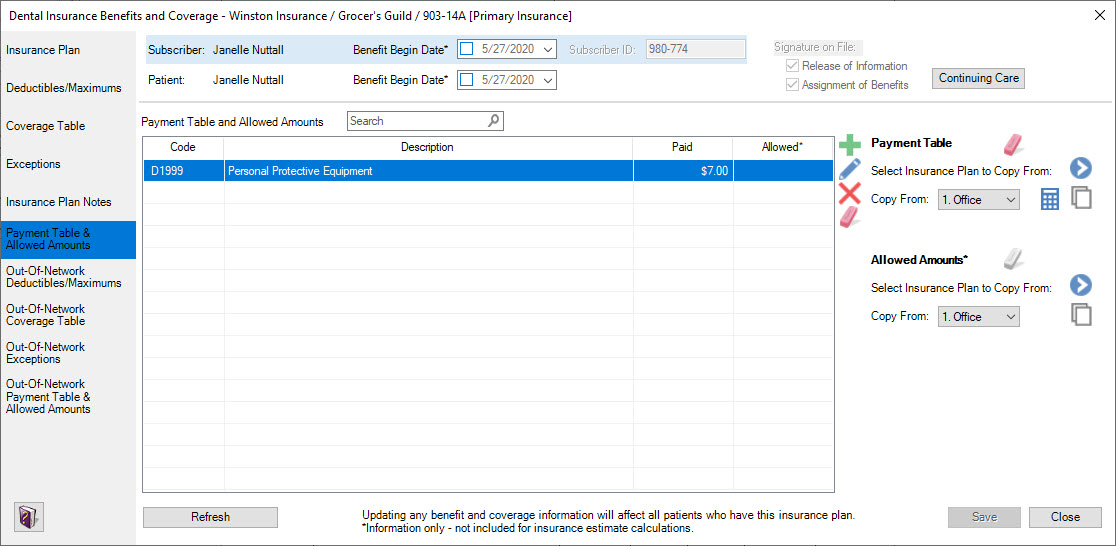
That way, when the code is set complete in the patient’s Ledger, Dentrix will estimate the insurance to pay $7.00 and the patient portion at $3.00. You can then collect the patient portion at the time of service. It’s always best to collect from patients at the time of service in order to reduce outstanding accounts receivable. Also, it wouldn’t be cost effective to send a patient a statement for a $3 balance.
Another great thing about updating the payment table is that when you enter new information into it, the insurance estimate will be used for all patients who are covered under that same insurance group plan. This will result in less data entry for your team.
I’m hearing from offices that patients are understanding of the cost for PPE, and even if their dental insurance isn’t going to cover the fee, they are willing to pay a reasonable fee to offset the cost for the office.
If you expect dental insurance to pay for a portion of the code, use the payment table to enter that information into Dentrix, so you can accurately collect any patient portion at the time of service. If you don’t expect any insurance payment for code D1999 for a particular group plan, you should enter $0 into the payment table, which will result in the charge being added to the patient portion in both the patient’s Ledger and in the Treatment Planner.
Charging patients and their dental insurance for the cost of additional PPE can help to offset the expense your office has incurred to purchase these items. The suggestions above can help you to set up Dentrix to make this process more streamlined.
Learn More
For additional information, see the following topics in Dentrix Help:
- Editing Procedure Codes
- Customizing Appointment Reasons
- Adding Insurance Claim Remarks
- Creating Clinical Note Templates
For additional information on COVID-19 topics, see the following:
*Please consult the laws and regulations in your state for guidance on charging for Personal Protective Equipment (PPE) and other COVID-19 related costs and particularities. You should not rely upon the material or information provided by HS1 as a basis of making any decisions without the proper legal or other professional advice specific to your situation as needed.
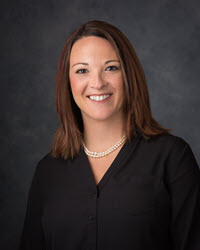
By Charlotte Skaggs
Certified Dentrix Trainer and The Dentrix Office Manager columnist
Charlotte Skaggs is the founder of Vector Dental Consulting LLC, a practice management firm focused on taking offices to the next level. Charlotte co-owned and managed a successful dental practice with her husband for 17 years. She has a unique approach to consulting based on the perspective of a practice owner. Charlotte has been using Dentrix for over 20 years and is a certified Dentrix trainer. Contact Charlotte at [email protected].





